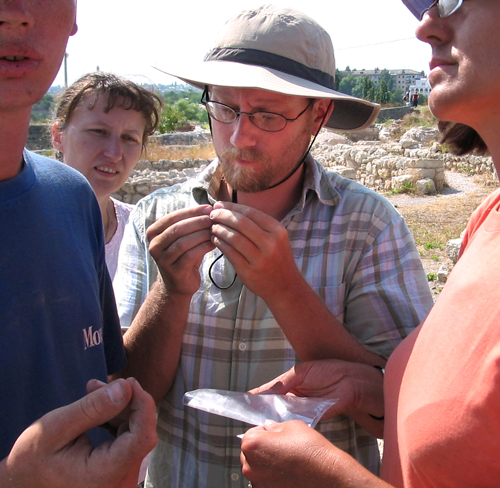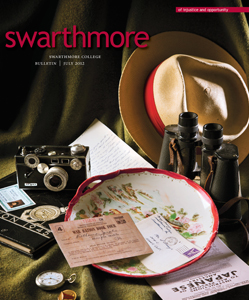The Digital Archaeologist
Adam Rabinowitz ’95 digs deep into new methods of discovery

Adam Rabinowitz examines a tiny intaglio gemstone from the Hellenistic or Roman period shortly after it was found during the 2005 excavation season at Chersonesos. Photo courtesy of the Institute of Classical Archaeology
If archaeologist Adam Rabinowitz ’95 were a superhero, he might be known as “The Destroyer.”
“Archaeology is inherently destructive. … You can’t re-dig a site … You took things that were associated, and now they are not associated,” he says. To maintain the context of finds, Rabinowitz and others are exploring new ways of using and preserving the rich and broad scope of digital data created from their excavations.
Through a series of happy accidents, Rabinowitz, a Phi Beta Kappa Greek and history graduate, began archaeological research at Chersonesos in Crimea, Ukraine, a decade ago. He was available, in Europe, and had the chops as a doctoral student at the University of Michigan to run a dig that was looking at the rural landscape of an ancient Greek colony. Chersonesos is located near Sevastopol, a region that has been the site of many conflicts. During excavations, World War II ordnance was found and disposed of more than once.
The site of Chersonesos has recently been nominated by Ukraine for inclusion in the UNESCO World Heritage List.
Several years ago, Rabinowitz, an assistant professor in the classics department at the University of Texas at Austin and assistant director of the Institute of Classical Archaeology (ICA), began the next stage of the life cycle of the excavation—the analysis and publication of the data—which has led him to new collaborations and discoveries.
For the last five years Rabinowitz has helped the National Preserve of Tauric Chersonesos carry out the Megarika Project, a program of digitization and online presentation that displays, with other material, unpublished glass-plate negative images of archaeological excavations from the 1890s to the 1950s. Now he is working on the online publication of material from his own excavation.
As Rabinowitz wrote in ICA’s most recent Annual Report, “new technologies make it possible to organize and present primary archaeological data from both survey and excavation in ways that have never before been possible. Yet at the same time, rapid changes in technology make it difficult to assure the preservation of our archives for future generations.”
For Chersonesos, this means the publication of the digital data will be layered “beneath a narrative so the reader can make sense of the material.”
But this does not solve the problem of preserving the digital material’s connections and context in the long term. This led Rabinowitz and his team to collaborate with the Texas Advanced Computing Center, which is focused on the storage and management of “dynamic and GIS [geographic information system] data and its presentation through interactive online services.”
With the help of computer scientists, Chersonesos has become a case study for a new way of working with digital data that will not rely on proprietary software to create meaning. Ultimately, Rabinowitz hopes a grant will help them “easily create metadata that will allow digital collections to be preserved for future reuse.”
Right now, when archaeologists work on a project like Chersonesos, a database is created, GIS information is gathered, images and photographs are made, and other materials are produced. This data is then stored on DVDs and a server as a means of preservation. The problem? In 15 years “none of it will work” because of changes in technology, according to Rabinowitz.
The new approach that he and his colleagues are working on is, in part, modeled on Rabinowitz himself.
In the past, he has collaborated on similar projects that used a top-down approach to the data—taking information and trying to enforce one-size-fits-all metadata standards. He wanted a system that was built from the bottom up and relied on archaeologists’ preferences.
The other challenge is extracting metadata automatically, while maintaining and exploiting links with the goal of ensuring the context for other scholars “in terms of decades or even a quarter century. We would like a century. We use stuff from 100 years ago. We’d like our material to present the same opportunity.
“Digging up stuff is a lot of fun, but it is basically selfish,” he adds. “We’ve focused so far on what digital methods can do, not on what will happen to digital data down the road. So it’s critical for us to start to think more carefully about how we’re going to preserve this new documentation, not just about how we can use cool new tools to create it.” With that in mind, Rabinowitz and other archaeologists may just go from “Destroyer” to “Digital Defender.”
For more on Chersonesos, go to http://chersonesos.org or http://www.utexas.edu/research/ica.
 Email This Page
Email This Page